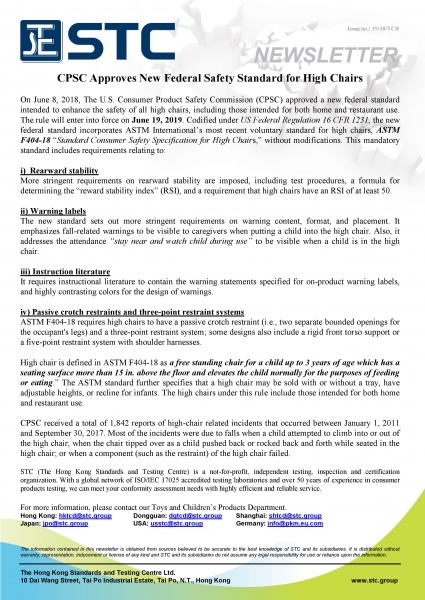
CPSC Approves New Federal Safety Standard for High Chairs
On June 8, 2018, The U.S. Consumer Product Safety Commission (CPSC) approved a new federal standard intended to enhance the safety of all high chairs, including those intended for both home and restaurant use. The rule will enter into force on June 19, 2019. Codified under US Federal Regulation 16 CFR 1231, the new federal standard incorporates ASTM International’s most recent voluntary standard for high chairs, ASTM F404-18 “Standard Consumer Safety Specification for High Chairs,” without modifications. This mandatory standard includes requirements relating to:
i) Rearward stability
More stringent requirements on rearward stability are imposed, including test procedures, a formula for determining the “reward stability index” (RSI), and a requirement that high chairs have an RSI of at least 50.
ii) Warning labels
The new standard sets out more stringent requirements on warning content, format, and placement. It emphasizes fall-related warnings to be visible to caregivers when putting a child into the high chair. Also, it addresses the attendance “stay near and watch child during use” to be visible when a child is in the high chair.
iii) Instruction literature
It requires instructional literature to contain the warning statements specified for on-product warning labels, and highly contrasting colors for the design of warnings.
iv) Passive crotch restraints and three-point restraint systems
ASTM F404-18 requires high chairs to have a passive crotch restraint (i.e., two separate bounded openings for the occupant's legs) and a three-point restraint system; some designs also include a rigid front torso support or a five-point restraint system with shoulder harnesses.
High chair is defined in ASTM F404-18 asa free standing chair for a child up to 3 years of age which has a seating surface more than 15 in. above the floor and elevates the child normally for the purposes of feeding or eating.” The ASTM standard further specifies that a high chair may be sold with or without a tray, have adjustable heights, or recline for infants.The high chairs under this rule include those intended for both home and restaurant use.
CPSC received a total of 1,842 reports of high-chair related incidents that occurred between January 1, 2011 and September 30, 2017. Most of the incidents were due to falls when a child attempted to climb into or out of the high chair; when the chair tipped over as a child pushed back or rocked back and forth while seated in the high chair; or when a component (such as the restraint) of the high chair failed.
[See PDF version for more information]










